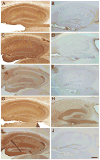Encephalitis and antibodies to dipeptidyl-peptidase-like protein-6, a subunit of Kv4.2 potassium channels
- PMID: 23225603
- PMCID: PMC3563722
- DOI: 10.1002/ana.23756
Encephalitis and antibodies to dipeptidyl-peptidase-like protein-6, a subunit of Kv4.2 potassium channels
Abstract
Objective: To report a novel cell surface autoantigen of encephalitis that is a critical regulatory subunit of the Kv4.2 potassium channels.
Methods: Four patients with encephalitis of unclear etiology and antibodies with a similar pattern of neuropil brain immunostaining were selected for autoantigen characterization. Techniques included immunoprecipitation, mass spectrometry, cell-base experiments with Kv4.2 and several dipeptidyl-peptidase-like protein-6 (DPPX) plasmid constructs, and comparative brain immunostaining of wild-type and DPPX-null mice.
Results: Immunoprecipitation studies identified DPPX as the target autoantigen. A cell-based assay confirmed that all 4 patients, but not 210 controls, had DPPX antibodies. Symptoms included agitation, confusion, myoclonus, tremor, and seizures (1 case with prominent startle response). All patients had pleocytosis, and 3 had severe prodromal diarrhea of unknown etiology. Given that DPPX tunes up the Kv4.2 potassium channels (involved in somatodendritic signal integration and attenuation of dendritic back-propagation of action potentials), we determined the epitope distribution in DPPX, DPP10 (a protein homologous to DPPX), and Kv4.2. Patients' antibodies were found to be specific for DPPX, without reacting with DPP10 or Kv4.2. The unexplained diarrhea led to a demonstration of a robust expression of DPPX in the myenteric plexus, which strongly reacted with patients' antibodies. The course of neuropsychiatric symptoms was prolonged and often associated with relapses during decreasing immunotherapy. Long-term follow-up showed substantial improvement in 3 patients (1 was lost to follow-up).
Interpretation: Antibodies to DPPX are associated with a protracted encephalitis characterized by central nervous system hyperexcitability (agitation, myoclonus, tremor, seizures), pleocytosis, and frequent diarrhea at symptom onset. The disorder is potentially treatable with immunotherapy.
Copyright © 2012 American Neurological Association.
Figures




References
-
- Frechette ES, Zhou L, Galetta SL, Chen L, Dalmau J. Prolonged follow-up and CSF antibody titers in a patient with anti-NMDA receptor encephalitis. Neurology. 2011;76:S64–S66. - PubMed
Publication types
MeSH terms
Substances
Grants and funding
LinkOut - more resources
Full Text Sources
Other Literature Sources
Medical

